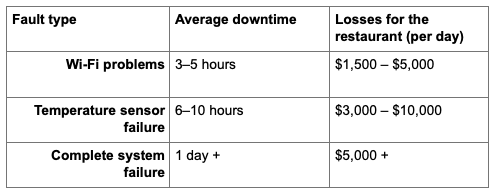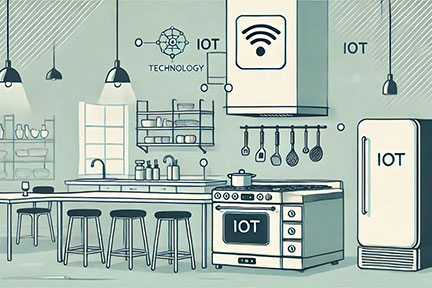
Digital technology has long since taken over the restaurant business: cash registers have become smart, orders have become automated, and now even kitchens have come under the control of algorithms. IoT ovens and stoves are connected to the cloud, monitor energy consumption, predict breakdowns, and, it would seem, make life easier. In theory, yes. In practice… Things aren’t so rosy.
In 2022, one of the major restaurant chains in the US felt it firsthand: a software update blocked remote access to kitchen equipment in dozens of establishments. The result — waiters explaining to customers that their steaks would be cooked, well… someday. Losses? Hundreds of thousands of dollars. And this is not an isolated incident.
Now the question is: Could this have been avoided? The answer is clearly yes. But it requires a more complex approach than simply “trusting technology.” Any technological system requires not only implementation but also competent support. This is especially true in regions with hot climates, where high humidity accelerates the wear and tear of electronics. In such cases, oven and stove repair in Fort Lauderdale becomes not just an option, but a vital necessity.
However, this raises another question: Is it worth investing in maintenance or is it easier to replace old equipment?
IoT Equipment: Enhanced Efficiency or Hidden Vulnerability?
Other than in pursuit of a trendy innovation, why are restaurant owners implementing smart systems en masse in the first place?
- Saving resources — systems automatically regulate temperature, reducing energy consumption.
- Minimize emergency breakdowns — sensors analyze the condition of parts and warn of risks.
- Remote monitoring — restaurant owners can monitor equipment even from out of town.
Sounds like a dream, doesn't it? But only as long as everything works.
When the software fails or the connection to the server goes down, the restaurant can literally freeze up. Think of how annoying it is when your phone suddenly freezes. Now imagine if the entire restaurant kitchen hangs up in the middle of dinner. At best, the food would just be undercooked. At worst, the place will close indefinitely because the equipment without a connection to the cloud refuses to turn on at all.
What are the most common problems?
- Dependence on the Internet. Loss of connection — and the “smart” stove becomes useless.
- Update errors. Developers, wanting to fix bugs, can accidentally (or not, if it is the work of competitors) introduce a new, even more destructive code.
- Physical wear and tear. Sensors and heating elements fail over time.
- Hot climate. In Florida, high humidity shortens the life of electronics by 25%.
The Cost of Downtime: How Much Does a Restaurant Lose per Day?
When a stove or oven breaks down, it's not just a technical concern. It's financial loss, dissatisfied customers, and reputational damage. In some cases, restaurants lose thousands of dollars a day.

In such a situation, the main question is not “Why did it break?” but “What to do next?”
Repair or Replacement: Which Is More Cost-Effective?
Repair is cheaper, but only if the equipment has not yet reached the wear and tear limit. Equipment up to 5 years old, as a rule, can still be repaired, especially if the problem is related to software or small components. But if you have a stove that's hopelessly glitchy and using too much energy, it may be easier to replace it (Maintworld).
Factors to consider:
- If the fault is software-related, in 80% of cases the problem can be solved by updating the firmware or replacing the control modules.
- If the equipment served well for 7–10 years in a temperate climate, in Florida conditions, it can break down in 4–5 years due to overheating of contacts and oxidation of elements.
- If the cost of repair exceeds 30% of the price of new equipment — perhaps replacement will be a more reasonable solution.
Alternatively, a hybrid approach can be chosen: equipment already in use can be upgraded with IoT sensors. Companies such as Spark Service PRO offer professional oven and stove repair in Fort Lauderdale, as well as smart kitchen equipment upgrades which can extend the life of appliances, given the aggressive climate of the southern states.
But even if you opt for a repair, an important question remains: which approach should you choose?
The Role of Service: Why Doesn't “Pay and Forget” Work?
Restaurant owners often rely on warranties and service contracts — and wrongly so. The fact is that standard warranty service rarely takes into account the peculiarities of operating equipment in high humidity and temperature conditions, and if they do, it affects insurance payments to the point of unprofitability.
Ideally, restaurants should contract with local service companies, if in Florida, such as Spark Service PRO, for oven and stove repair in Fort Lauderdale. The task of such companies is not just to repair breakdowns but to adapt appliances to the tropical climate of the southern states.
The best option is a hybrid approach: combine remote monitoring with regular local service. This allows you to go longer to promptly eliminate failures, but also to prevent their occurrence.
How to Minimize Risks and Protect Your Business?
- Scheduled maintenance. Don't wait for equipment to break down — prevention is cheaper than repair. Is that proven? Yes, and more than once. According to the US National Restaurant Association, more than 70% of emergency equipment breakdowns could have been prevented with regular maintenance. Restaurant owners who cooperate with service companies note that the cost of preventive maintenance is 30-50% lower than the cost of emergency repairs.
- Service contract. Choosing a reliable partner, as recommended Spark Service PRO (California, USA), will protect against unexpected costs and speed up repairs.
- Backup solutions. If a software glitch renders your stove unmanageable, you should have an alternative way to turn it back on.
Most importantly, don't rely on technology alone. They can work flawlessly… until they don't anymore.
The question isn't whether your IoT stove will break. It's a question of when and how catastrophic the consequences will be. And if your kitchen is the heart of your business, it's best to keep not only a plan A but also a plan B in reserve.

Conclusion
Technology is great… but only as long as it works without fail. Smart kitchens really simplify restaurateurs’ lives by reducing energy costs, preventing breakdowns, and allowing them to control equipment remotely. But when something goes wrong, the entire restaurant business is held hostage to hovering updates, crashing servers, and overheating electronics.
Can these problems be avoided? Yes, if you don’t treat IoT equipment as a magic wand that solves all problems. Even the smartest system requires no less attention than good old-fashioned mechanics. So the main conclusion is simple: smart kitchens should not only be smart but also predictable. And this requires a balance — technology plus service, automation plus redundant solutions.
After all, it doesn’t matter to the customer why his order is delayed. He has a menu in his hands, expectations in his head, and a question in his eyes, “What’s wrong with my steak?”
